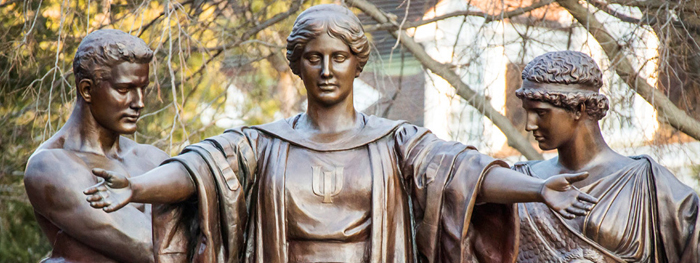Holding court: Alumnus Kevin Anderson climbs the tennis ranks
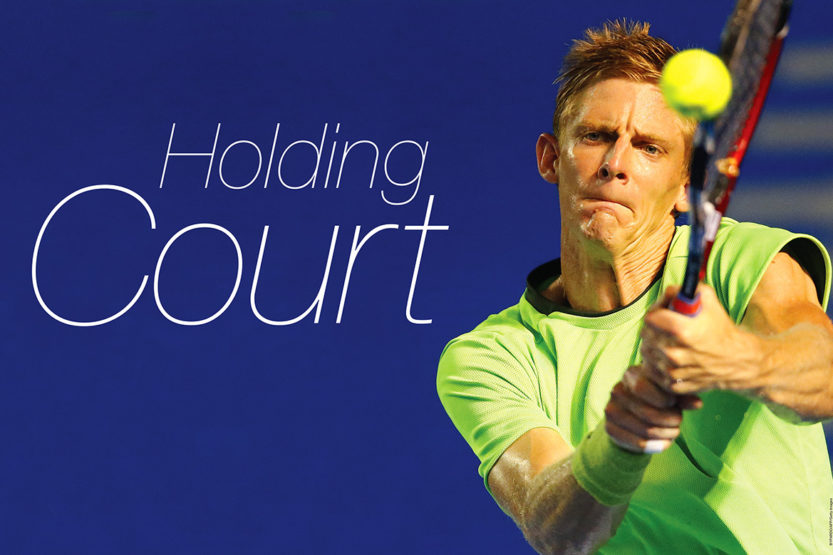 Former Fighting Illini tennis player-turned-ATP tour professional Kevin Anderson. (BYPARDO/AFP/GETTY IMAGES photo)
Former Fighting Illini tennis player-turned-ATP tour professional Kevin Anderson. (BYPARDO/AFP/GETTY IMAGES photo) Riiiiiiinnngggg!!!
Brad Dancer checked the time. It was 6 a.m. Who could possibly be calling at 6 a.m.?
Riiiiiiinnngggg!!!
“Hello?”
“Coach, it’s Kevin. I was wondering if you could come work me out?”
And so began a routine that persisted during Kevin Anderson’s three years at the University of Illinois, where he became the greatest tennis player in Illini history, a three-time All-American in singles and a two-time All-American in doubles.
“He got me out of bed every morning at six,” says Dancer, who was then an assistant coach and now serves as head coach of the Illini men’s tennis team.
Any coach would be pleased with such dedication, and Dancer was. But how about a girlfriend? When Kelsey O’Neal’s relationship with Anderson, ’07 ATTENDEE, was budding, she could recall times when they would “just be hanging out.” And then Anderson would peer at his watch and everything would change.
“I’ve got to get home,” he’d suddenly say. “I’ve got to get up early tomorrow for practice.”
O’Neal, ’09 bus, ’09 bus, who played golf for the Fighting Illini, knew not only athletics, but some of the other tennis players, and she knew there wasn’t a practice early in the morning.
“I couldn’t figure out why he didn’t want to hang out with me,” she says. “One time, I told him, ‘The other guys aren’t practicing that early in the morning, so what’s going on?’ That’s when he told me it was a private session with his coach.”
Still, it was difficult to reconcile. That’s when O’Neal called her older sister, Megan (O’Neal) Lehn, ’06 ED, a former Illini golfer, asking for advice.
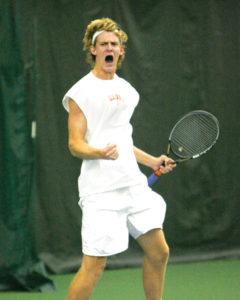
As a member of the Illini tennis team, Kevin Anderson earned All-American honors in singles three times. (Photo courtesy of UI Athletics)
“She told me, ‘Listen, Kelsey, he’s really talented, he’s a really good tennis player, and he’s very dedicated.’”
Little by little, she came to not only recognize that, but become extremely proud of it. And now, as Kelsey Anderson—she and Kevin are in the fifth year of their marriage—she speaks with pride about her husband’s work ethic and how it helped elevate him to a No. 10 world ranking in Fall 2015, the highest of any former Illinois tennis player.
“Whatever other people have told you about his dedication and work ethic, I would echo,” Kelsey says, sitting on the back porch of the couple’s home in Gulf Stream, Fla. “He has a level of dedication that I’ve never seen in anybody else, and I’ve seen a lot of dedicated people, both in and out of sports. I’ve never run across anybody like him.”
South Africa’s best junior player
Anderson is at a loss to explain why that is; it’s just always been. Growing up in South Africa, his father was an athlete, and playing tennis was a generational thing for the family—it was how Kevin was introduced to the game. But growing up, he competed in a variety of sports, such as cricket, cross country and swimming.
As he got older, he found himself gravitating more and more to tennis. On the wall beside his bed hung only one poster of an athlete—the great U.S. tennis champion Pete Sampras. As much as he could in a nation where tennis wasn’t one of the major sports, Anderson fervently followed the game and competed in youth tournaments.
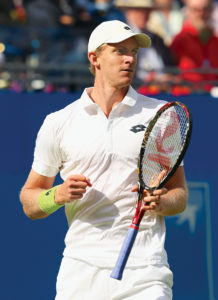
Anderson played against Lleyton Hewitt at the 2015 Aegon Championship at Queen’s Club in London. (Cliver Brunskill/Getty Images photo)
“My dad didn’t push me in any one direction,” he says. “He had aspirations for me in sports, in general, but it was clear that he liked tennis. In tennis, you don’t rely on ‘selectors,’ on other people determining whether you’re good enough to play. It’s an individual sport. So either you’re good enough, or you’re not.”
He was.
As Anderson progressed to becoming the best junior player in his country, the idea of one day turning pro crystallized. But when? One day, in February 2004, he got a call from the head tennis coach at the University of Nevada, Las Vegas, asking if he was interested in playing for them. Suddenly, a thought that hadn’t even been on the radar screen became a central idea to further his tennis career.
“The more I thought about it, the more attractive playing college tennis seemed,” Anderson says. “I’d have coaching, other good players to practice with, strength training, top competition.
“In South Africa, there weren’t enough people to practice against. South Africa is isolated from tennis. If I was going to turn pro one day, then [being] in the U.S. was going to be important.”
As soon as word got out that Anderson was considering a college career, more and more eyeballs came looking for him. At the time, the Fighting Illini’s head tennis coach was Craig Tiley, a South African. Needless to say, the home country connection was important to Anderson—Tiley had the good sense to introduce Anderson to South African tennis legend Wayne Ferreira—but still, there were about 15 other head coaches who were interested in recruiting him into their programs.
What impressed Illinois was not how well Anderson played, but how well he reacted when he wasn’t playing well. There was a junior tournament at the U.S. Open in August 2004, during which Tiley and Dancer, along with a dozen or more other college coaches, watched him play. Admittedly, he was nervous.
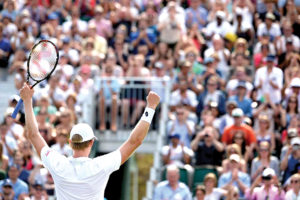
Anderson celebrates at Wimbledon, where he almost defeated Novak Djokovic, the No. 1 ranked tennis player in the world in 2015. (Photo courtesy of IMG)
“It was a most unpleasant experience,” Anderson recalls. “It was a first-round match, and I had all these college coaches watching me, and I felt like I had something to prove. I played awful.”
But that’s not what Tiley and Dancer observed.
“What we saw was a guy getting killed who never quit,” Dancer recalls. “We already knew Kevin had a great foundation with his tennis skills, but what we saw now was a great fighting spirit. He lost in straight sets, in the first round. But we knew from the way [he played] he would never give up; he was someone who could have a great college career.”
That evaluation was enhanced once Anderson joined the Fighting Illini.
“The biggest thing with Kevin is that he’s always had this unshakable belief that he could be a top 10 player in the world,” Dancer says. “Setbacks don’t affect him much. He’s always had a clear, defined path for himself. Because of that, he has an ability to brush off setbacks and keep charging ahead.”
Even if it’s six o’clock the next morning.
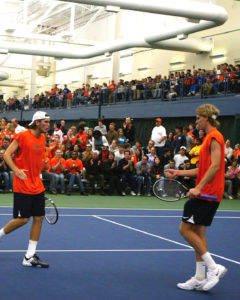
Anderson and his Illinois doubles partner, Ryan Rowe. The duo won the NCAA doubles championship in 2005 during their sophomore year. (Photo courtesy of UI Athletics)
Success at Illinois
The work habits continue with him now. A typical day, when he isn’t playing in a tournament, entails a morning warm-up and then a practice session, lunch, a little downtime, then gym work in the afternoon for cardio and weights, followed by physiotherapy and bodywork.
His college doubles partner and roommate, Ryan Rowe, ’07 ATTENDEE, recalls how he’d always see Anderson “doing more than what was required of him by the team. You’d come into the locker room, and Kevin would already be there, jumping rope. You’d come out on the practice court, and he’d already be working on something—the first guy there and the last to leave. You’d be going to class, and you’d look over and see Kevin running.”
The duo won the NCAA doubles championship their sophomore season in 2005 and then went all the way to match point of the championships before losing in their junior year in 2006. Anderson, who is 6-foot-8-inches, and Rowe, who is 6-foot-5-inches, recall that it was the first time they played a doubles match against players taller than them—in this case, a pair of 6-foot-10-inch players from Middle Tennessee State.
Mostly, though, they rarely lost.
“The thing I remember about Kevin is the focus and the intent,” Rowe says. “You knew that he did everything that he did because he had a vision of who he was and what he wanted to be.”
But to say it was all business would be off the mark.
“He’d be goofy,” Rowe says, laughing. “It’s hard not to be goofy when you’re 6-foot-8.”
The two gravitated toward silly movies, like Talladega Nights: The Ballad of Ricky Bobby and Super Troopers, which Rowe says they’d watch again and again. It was from Talladega Nights that they borrowed dialogue that became a pre-match ritual. In the movie, a racer asks Ricky Bobby (played by Will Ferrell) if he’d help him win, to which Ricky Bobby asks, in a deadpan retort, how could he help him win and also win himself. In their doubles matches, Anderson, a better server, would always serve first, but the duo fell into a goofy ritual that would cut through any pre-match jitters.
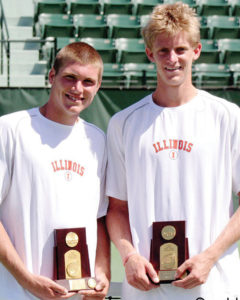
Anderson and his Illinois doubles partner, Ryan Rowe. The duo won the NCAA doubles championship in 2005 during their sophomore year. (Photo courtesy of UI Athletics)
Rowe: “Hey, Kev—do you mind if I serve first?”
Anderson (thoughtfully): “If you serve first, then how am I going to be able to serve first?”
When the two were back at Illinois last fall for an alumni event, they repeated the lines to each other just before stepping on the court.
“Kevin has that ability to be dedicated, but also fun-loving,” Rowe says. “Playing doubles with him, you never felt pressure. You’d feel the normal pressure of competition, but as a doubles partner, he was a guy you never felt pressure from, and I always appreciated that.”
It was his bond with teammates and his passion for playing for Illinois that made turning pro before his senior season so difficult for Anderson.
“I remember how emotional it was for him,” Dancer says, adding that the Illini tennis program makes no qualms that they are committed to helping their players become pros. “It is, of course, one of the reasons why Anderson chose Illinois to advance his career. So the fact that he left a year early, when he was ready to be a pro, wasn’t a shock. But it was still a difficult decision. His passion for his University runs deep.”
Tennis partners
When they were married in 2011, Kevin and Kelsey gave their wedding a University of Illinois theme, replete with an orange-and-blue cake and pastries. At the time, Kelsey, who graduated with two degrees—one in finance and the other in accounting (“I like to say she got one for me,” Kevin quips)—was working for the accounting firm Ernst & Young. Early in their marriage, she decided to quit and support Kevin’s burgeoning tennis career full-time.
“I handle all the accommodations—booking flights, hotel rooms,” she says. “I’m the bookkeeper, do the taxes, cook, pick up food, handle the scheduling—anything I can do to make Kevin’s life easier so he can show up and just play tennis. There are very few people who do that. In fact, there are only two or three women who travel with their partners full-time.”
“You have to be an independent person to do that,” she adds. “You have to be OK with going to see the Eiffel Tower by yourself. You have to be confident in yourself and OK with your partner’s career. I’m basically part of his business team.”
The reward is that they’re enjoying their 20s while traveling the world together. And Kelsey has become a bit of a celebrity on the Association of Tennis Professionals World Tour, penning a well-written and insight–ful blog called Tour Wife Tales for www.changeovertennis.com.
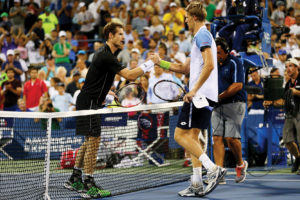
Anderson shakes hands with Andy Murray after defeating him during their fourth-round men’s singles match at the 2015 US Open. (Clive Brunskill/Getty Images photo)
She was with Kevin in China last fall when he learned that his lifelong goal of breaking into the top 10 of the world rankings finally had been achieved, thanks to strong showings at two of the four majors in 2015— Wimbledon and the US Open.
“I was at the Shanghai Masters, and people started telling me that the latest rankings had me at No. 10,” Kevin recalls. “I know it’s just a number but, for whatever reason, being in the top 10 is a coveted position. It made me reflect. I thought about all the hard work, just trying to make the top 100, then top 50, then top 30, top 15. It’s hard. You put in a lot of work and you kind of lose track … until you find yourself in the top 10, and you stop and reflect.”
A reporter from the News-Gazette in Champaign tracked down Tiley, who had recruited Anderson to Illinois and is now CEO of Tennis Australia, and asked him for his thoughts. “I was excited for Kevin and Kelsey, his wife,” Tiley said. “He’s a great poster boy for doing things the right way. He’s been extremely professional from the very beginning and committed to development. To be the best among the best, that’s a big accomplishment in any profession. He’s very deserving of it because he put in the work. He’s just taken the success he had as an Illini and put it on the world stage.”
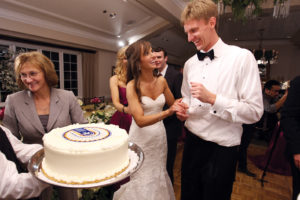
Anderson celebrates with his bride, Kelsey, at their Illini-themed wedding, which included a Fighting Illini-decorated cake, pastries and street sign. (Photo by Kenny Kim Photography)
The battle for No. 1
At Wimbledon in 2015, Anderson was seeded No. 14 when he met the world’s No. 1 player, Serbian Novak Djokovic, in a match where the winner would advance to the quarterfinals. Anderson won the first two sets (7-6, 7-6), setting up what would’ve been the biggest upset at the most prestigious of all the tennis Grand Slams. Not only was Djokovic the No. 1 player in the world, but he was Wimbledon’s defending champion. Djokovic came roaring back to win sets three and four by 6-1, 6-4. Play was suspended due to darkness, leaving the decisive fifth and final set for the next day.
The theme throughout the match was Anderson’s booming serve. Djokovic is considered perhaps the greatest returner of his generation, but he consistently struggled with Anderson’s serve, which reached speeds of 139 miles per hour and produced 40 aces over the match.
The following day, Djokovic battled to a 7-5 victory, which felt more like an act of survival to him, as evidenced by the fact that he dropped down and kissed the court in relief after the final point.
“This was one of the most difficult matches I have played at Wimbledon in my career,” Djokovic told reporters afterward, admitting that at times Anderson had him on the defensive and frustrated. “It was high-quality tennis. At times, I was helpless with my return—it was very difficult to read his serve, and he was very aggressive. I thought he played exceptionally well throughout the entire match. He was a very tough opponent.”
Anderson knows that, up two sets to none, the match was in his grasp. But does he harbor any what-ifs?
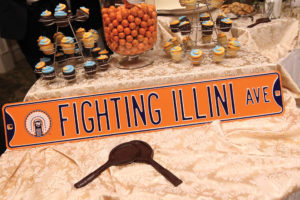
Anderson celebrates with his bride, Kelsey, at their Illini-themed wedding, which included a Fighting Illini-decorated cake, pastries and street sign. (Photo by Kenny Kim Photography)
“In that third set, there was a slight lapse in my quality of play, but other than that, I felt I played as well as I could,” he says. “I thought I played with a lot of confidence. I didn’t feel nervous. I felt calm and relaxed. It’s such a fine line, a fraction of this, a fraction of that, and it could’ve gone my way.”
With that renewed confidence, Anderson went to the US Open and played a match against No. 3 seed Andy Murray that was nothing short of epic. Murray had beaten Anderson in five of their previous six encounters, so the odds didn’t look good. But Anderson won in four sets—7-6, 6-3, 6-7, 7-6. What made the match epic was that, although only four sets, it was so fiercely contested that it lasted four hours and 18 minutes. Afterward, tennis legend and broadcaster John McEnroe said that the ending produced “one of the greatest tie-breakers you’ll ever see.”
The victory catapulted Anderson to the quarterfinals, a first for him in a major. “I used the Djokovic experience to my advantage,” he says. “I was determined to stay the course. I really believe it was a testament to all the work I put in.”
The grueling match against Murray did take its toll, though, with Anderson losing his quarterfinals match to Stan Wawrinka in straight sets.
Still, the two strong showings in majors helped catapult him to No. 10 in the world, with the realization that he isn’t through just yet. Anderson turned 30 on May 18, and he sees a lot more tennis left in him.
“If you compare my career to a five-set match, I believe I’m in the third set,” he says. “There are players who play into their 30s, and play very well. I know I can get better.”
And anybody who knows him knows that Kevin Anderson will do whatever work is necessary to reach that goal.

